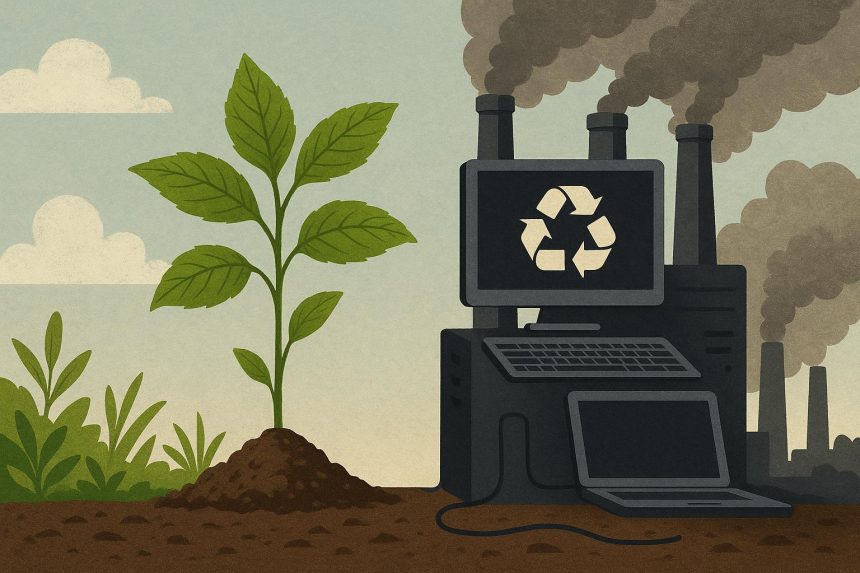AI is starting to help people make more sustainable choices without living life like a checklist. It is not telling people what to do, it is a question of making green the easiest choice. Let us say your tools are eco-sustainable suggestions, as easy as they are to access.
You need a new water bottle and care about the planet. You open the Sigma Browser sidebar and type in searches like “show me bottles made from recycled materials, see which brands have carbon-neutral shipping and find products that ship from warehouses nearby.” Sigma does the work for you by trawling through product pages, sustainability reports and shipping policies to provide you with a shortlist so you can buy guilt-free.
You can still live and take care of the planet. What if eco-friendliness was a way of life that involved being lazy, but in the best possible way?
How AI Is Reinventing Sustainability
Actual companies are already using AI to encourage individuals to be more eco-friendly, and the results are encouraging. For example, Too Good To Go has an AI-powered surplus food management system, which is used by food retailers like ALDI, Carrefour, SPAR, Coop and others. Their system tracks products with approaching expiration dates, gives advice on how to discount them, and helps stores reduce food waste and manage surplus more efficiently. That means less product in the trash, less money out and less stress on the earth.
There’s even research on greenwashing detection: AI programs are being trained to read sustainability reports and determine if companies are overstating their environmental efforts. One program was about 86% accurate in labeling sustainability reports for greenwashing risk.
As it happens, when well-designed, AI helps people, companies and retailers act more sustainably: waste less, are more transparent, utilize resources more intelligently. Imperfect, but it’s making a difference.
The Problem with Green AI
Not all AI that’s designed to save the world is automatically a hero, it’s sometimes a wolf in green sheep’s clothing. One of the main concerns is greenwashing: companies saying they are more sustainable than they really are. Generative AI is bearing a lot of the blame for it. Some chatbots have been accused of spinning very optimistic stories about energy use or environmental impact without having solid information to back it up. Global Witness said a collection of generative AI tools are greenwashing with extremely favorable portrayals of fossil fuel projects.
And here’s another: the idea that large model training is free climatically is a myth. According to a new paper, The Carbon Cost of Conversation, large language models can generate CO₂ equivalent to hundreds of cars during their lifetimes. The bigger or wordier your model, the larger its hidden footprint.
There is also the issue of deploying AI in supply chains: it can backfire. AI systems that perform inventory management and demand forecasting for grocery stores have been absolutely phenomenal at minimizing waste (e.g., in a pilot, the stores minimized food waste by ~14.8% using AI models like Shelf Engine and Afresh). But when datasets are biased or there is lots of noise in the supply chain, the same system can mess up demand forecasts, resulting in overorders or stockouts, which is a total headache.
So, yes, AI can help us live greener, but only if we address its blind spots, hidden costs and the gap between what it claims to do and what it actually does.
The Personal Eco-Assistant You Never Knew You Needed
It sounds great: a little agent in your browser that convinces you to make more sustainable choices without any guilt. That is what Sigma Browser Agent accomplishes. For example, suppose you are contrasting two brands of shoes. You head over to Sigma in your sidebar and type: “Find out which brand has recycled materials, which one has carbon-neutral shipping, compare total emissions, and choose the better one”. Sigma researches sustainability reports, shipping policies, third-party reviews, and gives you a verdict or sometimes two options with pros and cons for you to choose from.
If many eco-friendly choices were this effortless (the greener option first, the harder option hidden behind a click) maybe we’d see sustainable living not as a burden, but as the default.
The Bigger Picture
We’ve spoken about how AI is helping us shop more sustainably, how it could go wrong, and how an agent like Sigma would make making sustainable choices simpler. Let’s now take a step back. The real promise of AI in sustainability isn’t going to come from one perfect tool or one ideal use case, it’s going to come from a cultural shift: making sustainable habits less of a chore and more of something that occurs behind the scenes.
Global leaders are calling for sustainable AI, not just AI that serves others, but AI that is also mindful of its own energy, carbon, water, and material footprint. The World Economic Forum notes that AI and sustainability will be super critical to growth in this century, so we cannot have one without the other.
So, we can expect more intelligent but not more expensive AI assistants. They’re designed to be sustainable, so you don’t have to choose eco mode, it’s inherent. Imagine how great it would be if your browser suggested a greener version of what you already want: the same device, but from a firm that’s run on renewables, the same trip, but with less emissions, the same order, but delivered in a more sustainable way.
At the end of the day, saving the world is too big to carry all on your own. But if your browser speaks the smart way, it might help nudge humanity a tiny step closer to balance.
Lynn Martelli is an editor at Readability. She received her MFA in Creative Writing from Antioch University and has worked as an editor for over 10 years. Lynn has edited a wide variety of books, including fiction, non-fiction, memoirs, and more. In her free time, Lynn enjoys reading, writing, and spending time with her family and friends.















